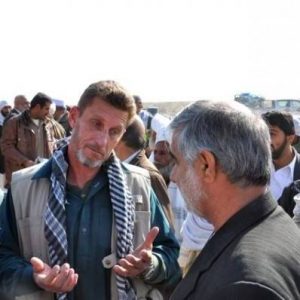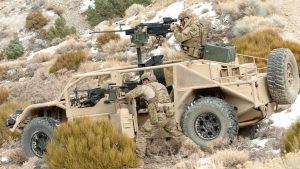The Taliban has been busy reminding the United States and her allies in Afghanistan that the moral is to the physical as three is to one. They have done this by side stepping our Security Sector Assistance (SSA) efforts in the Helmand and Nangarhar provinces by hitting the Afghan state where it is weak. Launching two large attacks inside the ‘Ring of Steel’ of Kabul (attacking the Intercontinental Hotel and the checkpoint outside the old Ministry of the Interior) and hitting a western NGO (Save the Children) in Jalalabad, the capitol of Nangarhar province.
The Special Inspector General for Afghanistan Reconstruction (SIGAR) released a report last September revealing that 60% of the funds expended since 2002, some 70 Billion dollars, were spent on developing Afghanistan National Security Forces (ANSF). In this report he listed several reasons why our efforts have borne little fruit.
The U.S. government was ill-prepared to conduct SSA programs of the size and scope required in Afghanistan. The lack of commonly understood interagency terms, concepts, and models for SSA undermined communication and coordination, damaged trust, intensified frictions, and contributed to initial gross under-resourcing of the U.S. effort to develop the ANDSF.
Initial U.S. plans for Afghanistan focused solely on U.S. military operations and did not include the construction of an Afghan army, police, or supporting ministerial-level institutions.
Early U.S. partnerships with independent militias—intended to advance U.S. counterterrorism objectives—ultimately undermined the creation and role of the ANA and Afghan National Police (ANP).
Critical ANDSF capabilities, including aviation, intelligence, force management, and special forces, were not included in early U.S., Afghan, and NATO force-design plans
Providing advanced Western weapons and management systems to a largely lliterate and uneducated force without appropriate training and institutional infrastructure created long-term dependencies, required increased U.S. scale support, and extended sustainability timelines.
To answer some of these shortfalls the US Army is developing Security Force Assistance Brigades (SFAB) that will be tailored to the mission and free up brigade combat teams. This idea, based on sound theory, will not work in practice. It won’t work for the same reasons it’s not working now; limited dwell time in country, high turnover of key personnel and the unwillingness to partner with host nation military units in combat.
Mentoring host nation military units does not take special classes on cultural awareness (although these help) or dedicated personnel; it takes the commitment to go into battle. It also takes sharing the same misery your local soldiers experience while demonstrating the leadership, tenacity and discipline required to prevail in the counterinsurgency fight.
As I pointed out in this post we know how to do it. Our problem is that we are too big and too complex organizationally to reinforce the limited success in the SSA mission we have achieved on the ground in both Iraq and Afghanistan. Former Marine and current Undersecretary of Defense Owen West wrote a book on how his team, and the ones that preceded him, did it in Iraq. American Spartan was another great book about a superb SF officer named Jim Gant who also broke the code on how to mentor in Afghanistan although he was not in the SAA role when he did it.
The Gant experience is important when dealing specifically with Afghanistan. As noted in the SIGAR report the central weakness of our Afghan assistance mission has been the inability of the central government to eliminate corruption and develop the efficiency needed to equip and maintain a professional military force. Jim Gant went into the most kinetic province of Afghanistan (Kunar) and stabilized a good portion of it by training up and directly supporting tribal militias. He accepted the reality that the central government will never control or be accepted by the hill Pashtuns living in the Hindu Kush.
The government in Kabul was established by and is currently maintained by the might of the American military (and her allies). We are westerners, we are not Muslims, we are attempting to create a system that is not organic to the people or region. It will not work.
The original Taskforce Southwest, with BGen Roger Turner at the helm has turned over with a new task force headed up by BGen Ben Watson. Turners Marines, who stayed inside the wire while mentoring ANSF, helped drive the incident rate down in Helmand province. They accomplished their mission and have brought some time and space for the Afghan army and national police. The big T Taliban have responded by hitting the Afghan government where its weak and where it hurts; inside the Ring of Steel in downtown Kabul. This is classical insurgent tactics; where the government is strong they are weak; where the government is weak they attack.
We have spent 70 Billion and counting to stabilize a country that is so unstable that our own diplomats and military cannot drive 2 miles from the international airport in Kabul to our own embassy. And it’s straight shot, down one road.
The center of gravity for both the Taliban and the central government is the people of Afghanistan. The SIGAR report identified our early partnership with militias as having undermined the creation and role of the ANA and National Police. This may be true but it is also irrelevant. Ignoring the powerful regional warlords while trying to marginalize them has consistently failed.
The current hit film, 12 Strong, portrays two of them, Abdul Rashid Dostum and Atta Muhammad Nur. Dostum was given a place in the central government by Karzai (Deputy Minister of Defense) and is currently the First Vice President of Afghanistan. Both positions were designed to sideline him and he has spent years in Turkey to avoid prosecution for killing political rivals and the Dash-i-Leili massacre of 2000 Taliban in 2001. Atta Muhammad Nur has been the governor of Balkh province sine 2004. In 2014 the current president fired all 34 provincial governors but Nur has refused to leave office and remains there to this day.
Both Nur and Dostum can raise and field thousands of Mujahideen. They may not be the type of leaders we would like to deal with but we are already dealing with and supporting them in official capacities that limit them and that’s not helping us. I wrote here about Ismail Khan who controls the western city of Herat and why it would be a good idea to bring his Muj into the fight. There is also Abdul Karim Brahui, former governor of Nimroz province and one of the warlords who was effective against the Soviets and Taliban and has never been accused of human rights violations. That’s just four of the dozens of local leaders who could raise Muj forces.

If the Afghan central government is not going to work (and it isn’t) then the only way forward is to incorporate ANSF units with the forces of regional warlords. The warlords bring a sizable chunk of the population with them; it’s that simple. The people are the prize and the central government doesn’t represent the people, regional warlords do because in Afghanistan that’s the way it is.
The US military could have worked wonders embedding with these warlords like they did in 2001 but that window has closed. The only rational way forward is to incorporate Mujahideen into the fight against the Taliban by using contractors for liaison and access to American enablers (Tac Air, Drone feeds, Artillery etc..). These contractors need to be already known to and accepted by the warlords (that pool of men is larger than most would suspect).
I emphasize rational because rational people care about how expensive things are and the US Armed Forces are too damn expensive. Check this article out about the new SF Battle Buggies. Contractors don’t need million dollar battle buggies – they’ll use the same beat up Toyota Hi-Lux trucks the Muj are using. We’re a cheap date and yes this argument is self serving; limit the selection pool to guys who are known and accepted by warlords and I’m back in the game (inshallah).

I know my assessment and recommendations will fall on deaf ears just as the SIGAR report from last September did. That’s too bad because we’re still spending a fortune on a failed strategy. We’re still losing servicemen too because the Army is sending advisors into combat with the Afghans in Nangarhar province while the Marines are not doing that in Helmand province. If we had a competent press corps that would the story they would be out to answer. But that’s not going to happen so ‘we the people’ have little idea what exactly is happening with the cash were expending and troops we are sending to Afghanistan.
That’s a shame too because we made promises to the Afghans that we are not keeping. The inability to keep your promises is bad for individuals (see Jordan Peterson’s excellent 12 Rules for Life for a detailed explanation why) and bad for countries too.



Yup. Then-Col Alford had a line a while back about partnering only being real if “you shit where they shit.” Goes double for us riding around only in MRAPs alongside Afghans in Danger Rangers. Complexity and bureaucracy are a big part of the problem, but risk aversion deserves the lion’s share of the blame I think.